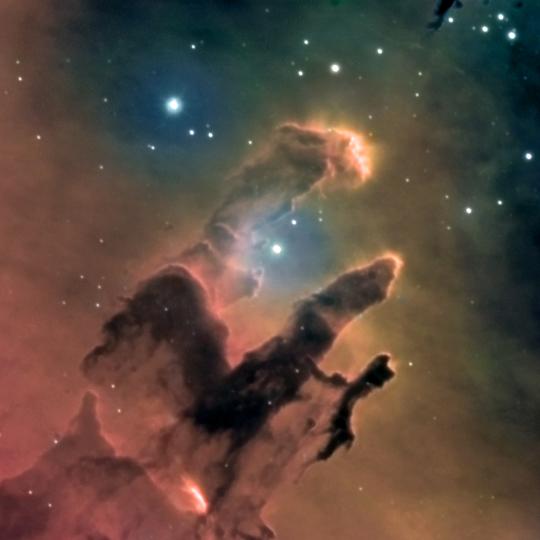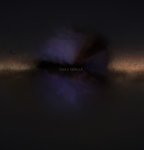You are using an out of date browser. It may not display this or other websites correctly.
You should upgrade or use an alternative browser.
You should upgrade or use an alternative browser.
Herbig AE/BE Stars
- Thread starter Jhyrryl
- Start date
Ian Phillips
Volunteer Moderator
Someone long ago was very disappointed by this very thing.
Then some time later he was very enthusiastic about exactly the same thing.
The difference?
He realised that by 3301AD the Pillars of Creation as you have pictured will no longer exist, and the game is depicting the eagle nebula more as it will be, than as an anachronistic picture of its current state.
Then some time later he was very enthusiastic about exactly the same thing.
The difference?
He realised that by 3301AD the Pillars of Creation as you have pictured will no longer exist, and the game is depicting the eagle nebula more as it will be, than as an anachronistic picture of its current state.
Also, the NASA images are false-colour. To the naked eye, they would not look like that anyway.
Someone long ago was very disappointed by this very thing.
Then some time later he was very enthusiastic about exactly the same thing.
The difference?
He realised that by 3301AD the Pillars of Creation as you have pictured will no longer exist, and the game is depicting the eagle nebula more as it will be, than as an anachronistic picture of its current state.
I am happy he ended up so enthusiastic about this. However, somewhere I read that stars eating up a nebula will at least take some 20,000 years so a mere 1,000 years will not alter its appearance that much. But of course it's valid to assume that in a thousand years things will look differently, however slight this difference might be.
What I was getting at is this: FDev could have implemented those colourful nebulae we know from Hubble et al. the way we see them on pictures. I bet modelling them in a 3D fashion for a sci-fi game would have been possible with current computer technology. FDev chose not to do so but instead implemented vague nebulae templates that may be not that sophisticated in resemblance to their 'real space' counterparts.
The difference?
Expectations were not met and things look a lot duller and 'copy-pasty'.
I won't start an argument here, just pointing out that in my view not implementing those nebulae the way hobbyists see them on Hubble pictures was a mistake that made the galaxy a bit more underwhelming.
- - - - - Additional Content Posted / Auto Merge - - - - -
Also, the NASA images are false-colour. To the naked eye, they would not look like that anyway.
True. But I was getting more like 'make the game more exciting' by making those things as posh as can be, because people will go there.
True. But I was getting more like 'make the game more exciting' by making those things as posh as can be, because people will go there.
I did make a post in the suggestions forum many moons ago that our windscreens should have a smart filter installed that can allow us to look at non-visible parts of the spectrum with false colour, overlaying or instead of the visible spectrum.
I reckon it'd be awesome, but I'm not holding my breath. It's probably an incredibly large amount of work to pull off even if FD want to do it.
Someone long ago was very disappointed by this very thing.
Then some time later he was very enthusiastic about exactly the same thing.
The difference?
He realised that by 3301AD the Pillars of Creation as you have pictured will no longer exist, and the game is depicting the eagle nebula more as it will be, than as an anachronistic picture of its current state.
Pretty much this. The nebula is about 7000 LY away and was rocked by a supernova about 8000 years ago that would have cleared out and rearranged the gas and dust after a 1000 years. So even from Earth, the pillars of creation would just be a star cluster with more diffuse nebulosity and maybe a few new bok globules resulting from the shockwave. It is believed that the Sun was propelled into existence in a similar shockwave induced collapse. Closer to the nebula, it would look 7000 years older and thus even more different.
Which also brings up another interesting point. Have you ever noticed that nebulae don't look quite the same from several thousand LY away as they do from 15 LY away? And that on each jump, they change a little bit. I always assumed this was just due to a rendering LOD issue, but maybe (we can pretend
Last edited:
Ian Phillips
Volunteer Moderator
No - I hadn't noticed it in the way you mention. I just put any changes down to the difference in aspects because of the 3D viewing from a (slightly) different angle.
Well, this got me thinking. And of course time seems to be the solution here, and I completely forgot about it.
Indeed, when we travel to the nebula, we also travel back in time. Or better, we travel towards the nebula's future. For us Sol dwellers the nebula is seen as being 7,000 ly in the past, but when we travel to it, we more and more travel towards its 'present', until we see it in its contemporary state.
Fascinating stuff!
Indeed, when we travel to the nebula, we also travel back in time. Or better, we travel towards the nebula's future. For us Sol dwellers the nebula is seen as being 7,000 ly in the past, but when we travel to it, we more and more travel towards its 'present', until we see it in its contemporary state.
Fascinating stuff!
No - I hadn't noticed it in the way you mention. I just put any changes down to the difference in aspects because of the 3D viewing from a (slightly) different angle.
You can really see it when fly straight towards Orion and barnards. Especially the filaments at the fringes of the nebula. I am sure it's just LOD but it could just as easily be minor variations in a state of collapse or diffusion from radiation pressure caused by internal star formation.
For us Sol dwellers the nebula is seen as being 7,000 ly in the past, but when we travel to it, we more and more travel towards its 'present', until we see it in its contemporary state.
Fascinating stuff!
Exactly. As we travel in witch space we are also acting as stellar "geologist" looking at strata of slices of time. And since we can defy the laws of physics and travel at FTL, we can even observe the earth as it was 10,000s years ago.
That means the further we fly on Distant Worlds the more we just fly out into the blue. Who knows if all those waypoints will still be out there?
Yeah, I know. People have already been there, no deal. Still, mind numbing...
Yeah, I know. People have already been there, no deal. Still, mind numbing...
That means the further we fly on Distant Worlds the more we just fly out into the blue. Who knows if all those waypoints will still be out there?
Yeah, I know. People have already been there, no deal. Still, mind numbing...
It's also fun to imagine what it would really look while flying in supercruise.
Planets spinning faster and speeding up along their path as you chase them, slowing down and going backwards when you hurry away from them.
When you look back after arriving you see yourself traveling backwards to where you came from, appearing in multiple places depending on speed and course changes, echos from the past crashing into each other. Travel in a system with black holes and it will be a big ballet of visual echos, you can chase yourself.
In reality all stars move at different velocities as well. The fastest star moves at 1162 km/sec out of the galaxy, or one whole light year every 258 years. It would appear to move quite a bit while traveling to Beagle point.
Since we're already at the Greae Phio Stellar forge, looking back at Earth you would see it as it was long before the first pyramids were built, 11.7k bc. Actually it will be quite distinct as that was when the last ice age ended. It will take to beyond Rendezvous point to see far enough back before the first cave paintings. To see dinosaurs we'll still need to go a thousand times as far as Beagle point.
Last edited:
When I realized this purple nebula formation is cut and pasted across the galaxy (realized this after flying through Witch Head and coming upon Running Man and thinking it was a bug that I had identical nebulae front and back), I dubbed these the Crappy Purple Mercedes.
It'd be really cool for the background stars to red/blue shift.It's also fun to imagine what it would really look while flying in supercruise.
It'd be really cool for the background stars to red/blue shift.
They would blue shift quickly into the invisible x-ray spectrum so you wouldn't see any stars. But the cosmic microwave background radiation would be blue shifted until you saw some similar to the gateway to the afterlife:

Yeah, but I'm with Andrew on this...I'm looking for art more than reality.They would blue shift quickly into the invisible x-ray spectrum so you wouldn't see any stars. But the cosmic microwave background radiation would be blue shifted until you saw some similar to the gateway to the afterlife:
http://i.kinja-img.com/gawker-media...l_progressive,q_80,w_800/18bgog6zx2cnujpg.jpg
I agree that the game looks better this way. The issue with having a psuedo blue shift is that Sci-fi is built on a house of cards and losses its street cred when it stops being consistent. Besides the whooshing blurs can't be stars, at least not ones in normal space. Otherwise a trip to a star that is 4 LY away would barely change the skybox and only the closest stars would have a noticeable change in position.
I like to think of hyperspace as somewhere else entirely. Another dimension where the positions of stars are jumbled in a hyper-dimensional space, and we are really moving orthogonally to normal minkowski 4 space to get there.
I like to think of hyperspace as somewhere else entirely. Another dimension where the positions of stars are jumbled in a hyper-dimensional space, and we are really moving orthogonally to normal minkowski 4 space to get there.
We were talking about in-system supercruise, when you're travelling at relativistic speeds. It'd be cool for the stars in front of you to go bluish, the stars behind you to go reddish, and if you're going to go far enough to make your skybox objects editable in real-time, you might as well implement tunnel-vision, too.I agree that the game looks better this way. The issue with having a psuedo blue shift is that Sci-fi is built on a house of cards and losses its street cred when it stops being consistent. Besides the whooshing blurs can't be stars, at least not ones in normal space. Otherwise a trip to a star that is 4 LY away would barely change the skybox and only the closest stars would have a noticeable change in position.
I like to think of hyperspace as somewhere else entirely. Another dimension where the positions of stars are jumbled in a hyper-dimensional space, and we are really moving orthogonally to normal minkowski 4 space to get there.
Yeah, but I'm with Andrew on this...I'm looking for art more than reality.I already accept a lot of fiction and immersion-breaking visual artifacts, so gimme cool visuals to compensate.
My thoughts in a nutshell (i.e. my brain)
Cheers!



